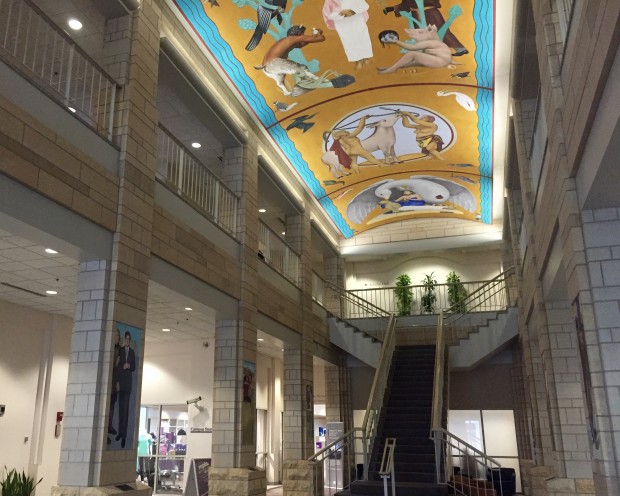
Minnesota native and world-renowned artist Mark Balma is known for his lifelike portraits of everyone, from celebrities to presidents to homeless men and women, and has announced his hopes to paint a portrait of Pope Francis.
St. Thomas, home to numerous sculptures and paintings created by local artists, boasts one of Balma’s masterpieces – the largest fresco in the U.S. stretched across the ceiling of Terrence Murphy Hall on the Minneapolis campus.
“It warms up the walls and makes a more comfortable environment,” said Director of University Collections Michelle Nordtorp-Madson. “Seeing the art around campus, people get a better understanding of how art integrates into everyday life.”
Sophomore Emma Dimassis said she enjoys passing the artwork on campus when she walks to class. She agrees that it makes campus more welcoming.
“It’s cool that St. Thomas wants to bring in art on campus. It feels like they really try to better the school,” Dimassis said.
Nordtorp-Madson thinks having professional artists produce work for St. Thomas benefits the community.
“It benefits us as a place where art is valued,” Nordtorp-Madson said. “We encourage art because it is part of our liberal arts education.”
Sophomore and art history minor Mollie Laidly said she passes the fresco almost every day as she goes to work on the Minneapolis campus. She believes that anyone can enjoy the art on campus.
“I think anyone, even if they haven’t taken an art history class, can appreciate the art here. Part of being human is seeing and valuing art,” Laidly said.
The 112-foot by 17-foot fresco, completed by Balma in 1995, was meant to reflect St. Thomas’ religious values. The work depicts the seven virtues discussed by St. Thomas Aquinas in his “Summa Theologiae” and is the focal point of the building’s Hall of Founders.
While the symbolism of the fresco ties into the St. Thomas Catholic identity, Nordtorp-Madson noted that the technique Balma used was even more significant. According to the St. Thomas webpage about the frescos of St. Thomas, Balma used the same materials and methods as the great fresco masters. These ancient techniques included using lime provided by the Vatican quarry – the same lime Michelangelo used for the Sistine Chapel.
Balma wants to use his paintings as a way to help the poor around the world. He hopes to sell 7 copies of his latest work, a portrait of Jesus, to a person on each continent and raise $7 million to fund social justice projects.
Claire Noack can be reached at noac8702@stthomas.edu.



